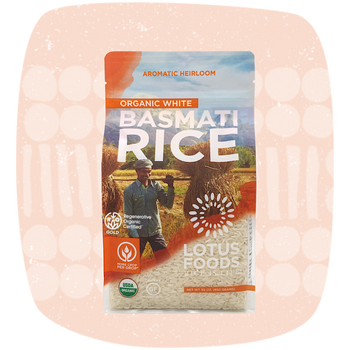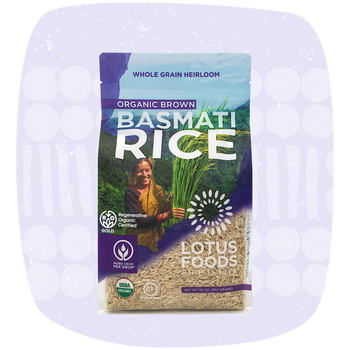Lotus Foods Leads The Way With Regenerative Organic Certified® Rice
August 10, 2021
Lotus Foods’ Organic Brown and White Basmati is the first rice in the world to achieve Regenerative Organic Certified® (ROC®). Wow! That’s amazing, isn’t it!? But what does ROC® actually mean? Good question. And why does Lotus Foods care? Another good question.
Let’s backtrack a bit. It’s 2017 and several well-known brands such as Dr. Bronner’s and Patagonia together with Rodale Institute were organizing information sessions at the Spring and Fall New Hope Network Natural Products Expo trade shows about a new standard they’re developing that will go beyond the existing national organic standards. They’re calling it “Regenerative Organic Certified®”. Lotus Foods co-founders and co-CEOs, Caryl Levine & Ken Lee, are intrigued – since 2008, Lotus Foods has been championing farmers growing rice using System of Rice Intensification (SRI)/More Crop Per Drop® practices, which build soil health, conserve water, and reduce greenhouse gas emissions; at times we’ve referred to this method as “beyond organic.” This new standard might be a way to validate the many social and environmental benefits of this agroecological farming method.
In the information sessions, the organizers made the case that, while national USDA organic standards have successfully banned synthetic fertilizers, pesticides, herbicides, GMOs, antibiotics, and growth hormones used in conventional agriculture, they do not go far enough in addressing soil health, fair labor practices, and animal welfare, which were part of the original organic movement. Many farming operations can meet the national organic certification requirements without their production practices being either sustainable or regenerative. Intensive tillage or plowing, for example, can increase soil erosion, nutrient runoff into nearby waterways, and the release of greenhouse gases into the atmosphere. The recent decision to allow in the national organic standards, food grown in water without soil, is also at odds with the spirit of organic agriculture.
SRI practices build soil fertility, increase water holding capacity, sequester carbon, and reduce methane gas emissions from paddies.
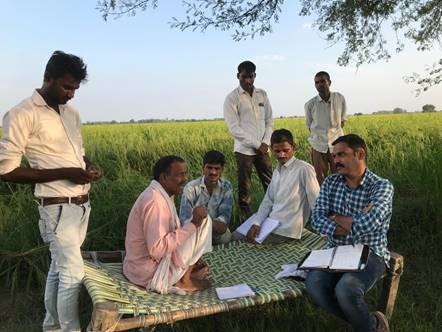
According to Regenerative International, “Regenerative Agriculture” describes farming and grazing practices that, among other benefits, reverse climate change by rebuilding soil organic matter and restoring degraded soil biodiversity – resulting in both carbon draw-down and improving the water cycle. Regenerative organic agriculture not only maintains resources but improves them. A white paper published by the Rodale Institute in 2014 and recently updated asserts that “global adoption of regenerative practices across both grasslands and arable acreage could sequester more than 100% of current anthropogenic emissions of CO2.”
In 2018, the Regenerative Organic Alliance (ROA), the non-profit established to guide the development and implementation of the Regenerative Organic Certification, announced plans for a pilot launch in 2019. They circulated for comment a draft of the proposed standards among a wide swath of stakeholders from farmers and ranchers to companies like Lotus Foods, who had shown an early interest. The goal of the pilot process was to develop a greater understanding of how ROC® standards could be implemented at the field level and use that experience in finalizing the standards for adoption worldwide.
The baseline for the new Regenerative Organic standards would be organic certification by the USDA or the equivalent in other countries. Thus ROC® would not be a substitute for the USDA Organic seal. Rather, it would be an “add-on” label, with additional higher standards required under three pillars: soil health; social justice; and animal welfare.

ROC® has additional higher standards required under three pillars: soil health, social justice, and animal welfare.
In reviewing the draft standards, Lotus Foods raised concerns that they seemed to be pitched to large American farmers managing vast tracts of land. For the standards to have global relevance, they would need to reflect the challenges of small-scale farmers, cultivating maybe only an acre or two, which is the case for many of the farmers producing rice for Lotus Foods. Another issue was cost. The expense of extensive soil testing might be prohibitive. Even $20 for a family rice farmer could be unaffordable. And finally, restrictions around tillage could also eliminate rice farmers who need to plow their fields between crop rotations but do so very shallowly. To ensure that the voice and needs of small farmers were included in the further development of the standards, and at the urging of Dr. Bronner’s on behalf of ROA, Lotus Foods expressed its interest in participating in the pilot program.
Lotus Foods was ultimately one of 19 brands and farms selected to pilot the Regenerative Organic standards. Sixteen different commodities as diverse as dairy, mangoes and cereals were represented in the pilot. Lotus Foods offered the opportunity to gauge the application of the standards under the conditions of subsistence rice farmers, who manage plots of land that are a fraction the size of most farms and ranches in the US.
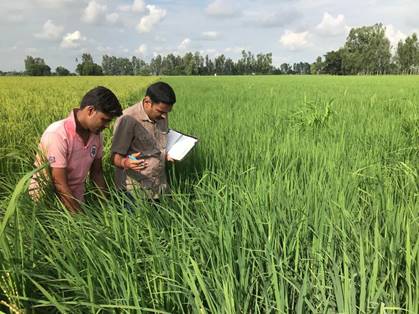
Farmers producing Lotus Foods’ Brown and White Organic Heirloom Basmati Rice in Uttar Pradesh, India.
In consultation with PraTithi Organics, Lotus Foods’ long-time supply partner in India, it was agreed that farmers producing Lotus Foods’ Brown and White Organic Heirloom Basmati Rice in Uttar Pradesh would be good candidates to participate in the pilot. Besides being well trained on applying SRI/MCPD® practices, they were already certified both organic and Fair Trade. Since they do not engage in animal production, that pillar did not apply.
SRI practices fundamentally change the environment in which rice is grown. Instead of keeping fields continuously covered with water, which decreases the amount of oxygen that reaches the topsoil and roots, fields are kept aerobic through intermittent drainage and fertilized with organic matter. The result is more extensive root systems and a proliferation of diverse soil microorganisms that nourish the plants and need oxygen to survive and thrive. Research shows that SRI practices contribute to building soils and soil fertility, while increasing water holding capacity, sequestering carbon, and reducing methane gas emissions from paddies.
In October 2019, an auditor for Ecocert, who was trained on the ROC® standards, spent almost a week in the field, visiting with farmers and the management team at Pratithi Organics. And in Spring 2020, we were informed that the farmers had achieved ROC®/Silver. ROC® has three levels, including Bronze, Silver and Gold. Bronze is the beginning level and Gold is the highest achievable level. This tiered approach enables producers to adjust and adapt their practices over time and allows for continuous improvement. Only operations that reach ROC® Silver or Gold certification levels are eligible to make product claims or use the ROC® logo on packaging. Thus, starting in Spring 2022, shoppers will be seeing the ROC® logo on our retail bags of Brown and White Basmati Rice.
In Spring 2020, we were informed that our basmati rice farmers had achieved ROC® Silver.
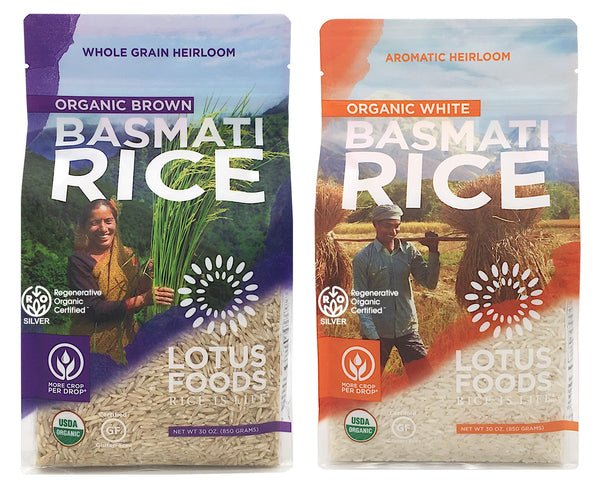
We couldn’t have been more thrilled to have it confirmed that SRI/MCPD® practices qualify as Regenerative Organic Certified®. We are now considering whether to seek official certification for our other organic and Fair Trade certified MCPD® rices, such as Organic Tricolor Blend Rice and Organic Jasmine Rice.
Since Lotus Foods’ participation in the pilot and subsequent receipt of ROC®, we’ve become aware of a number of other initiatives promoting regenerative practices. The focus of the Real Organic Project is on soil health and family farmers. The Savory Institute’s Land to Market program has developed an Ecological Outcome Verification (EOV) protocol, which measures key indicators of ecosystem function to track the overall health of a landscape.
The emergence of these new initiatives reflects a growing sense of urgency that we need to transform how we produce food and fiber around the world. The unfortunate reality is that industrial agriculture and the factory farming of animals are top contributors to climate change and have degraded soils to dangerous levels around the world. It is reported that the United States is losing soil 10 times faster—and China and India are losing soil 30 to 40 times faster—than the natural replenishment rate. As a result of erosion over the past 40 years, 30% of the world’s arable land has become unproductive.
Some scientists have argued that we have only 60 harvests left. Even if this is a doomsday prediction and harvests continue hundreds of years from now, working with degraded soil will reduce yields further, increase water needs, deplete aquifers, and in the U.S. create even more reliance on crop insurance and bailouts.
Another worrying consequence of poor soil quality is the effect on human health. More than half of the world today suffers from “hidden hunger,” a condition defined by a deficiency of micronutrients, despite getting enough daily calories. According to the Rodale Institute report The Power of the Plate: The Case for Regenerative Organic Agriculture in Improving Human Health, organically managed soils contain higher levels of microbial diversity and organically produced foods possess higher levels of bioactive phytochemicals than conventionally managed soils and foods. Interestingly, a comparison of rice grown under flooded conditions with organic amendments and rice grown under SRI in non-flooded soils with the same organic amendments found higher concentrations of the micronutrients copper, iron, zinc and manganese in the grains and straw of the SRI-grown rice. This is likely due to the higher microbial activity in the aerobic soils.
There was some discussion within Lotus Foods about whether having another icon on our packaging will confuse shoppers and undermine confidence in the USDA Organic seal. On the contrary, we believe consumers will be curious to learn about how ROC® compares to USDA Organic standards, and what additional practices are required. We also believe consumers will appreciate the opportunity to reduce their carbon footprint and demonstrate through their purchases support for the farmers, ranchers, and brands who are at forefront of catalyzing needed change.
In announcing Lotus Foods’ successful certification, Elizabeth Whitlow, ROA Executive Director, noted: “Companies like Lotus Foods have long been leading the way on innovation in regenerative rice production methods and are essential for shifting our food system.”
Resources
Lotus Foods Regenerative Organic Certified® Basmati Rice
Regenerative Organic Certified®
Cornell University | System of Rice Intensification
Regenerative International | What is Regenerative Agriculture?
Rodale Institute | Regenerative Agriculture and the Soil Carbon Solution
The Counter | Farmer's & Food Companies Regenerative Organic Certification®



